Are you a passionate cook looking to add some fresh flavor to your kitchen? Or maybe you’re a budding herb enthusiast who enjoys having herbs on hand for easy access and convenience. Whichever the case, basil is a great herb to have around for either usage since it has multiple applications in both savory and sweet dishes! One easy way to start growing basil is by taking cuttings from an already existing plant. This blog post will provide you with all the necessary information on how to propagate basil using cuttings. From understanding what cutting material supply works best, determining when the best time is for creating cuttings, as well as picking out a suitable container and location – plus more – we’ve got all your bases covered so that you can be successful with your project!
Benefits of Growing Basil From Cuttings
Starting a herb garden by growing basil from cuttings is a quick, easy, and cost-effective method. In addition to being an economical way to get your herbs started, there are many benefits associated with growing basil from cuttings.
One of the most appealing aspects of using cuttings is that you can easily propagate your existing plants, so you don’t have to purchase new seeds each time. This means less money spent on purchasing supplies and more time spent tending to your herbs. Furthermore, since you’re using existing plants instead of starting from scratch, you can be sure that they will produce high quality leaves right away. [1]
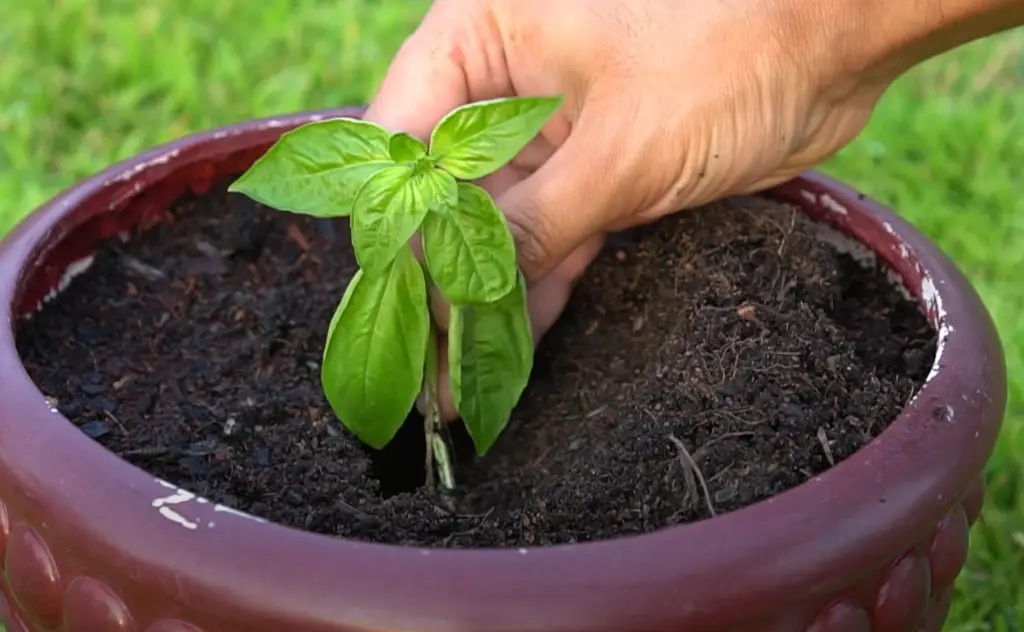
Another major benefit of growing basil from cuttings is that it allows you to save time on the growing process. Unlike starting herbs from seeds, where you have to wait for them to germinate and then care for them until they’re ready to harvest, cuttings are much faster. This means that you can enjoy your herb garden sooner rather than later.
Finally, propagating basil from cuttings also helps ensure genetic diversity in your herb garden. By taking a cutting from one plant and using it to start another, you can ensure that the plants in your garden will be diverse and healthy. This ensures that any pests or diseases won’t spread too easily throughout your garden and make it easier for you to produce high-quality yields of basil.
Overall, growing basil from cuttings is an excellent way to start your herb garden. Not only does it save you time and money, but it also helps ensure genetic diversity and high-quality yields of herbs. So, if you’re looking for a fast and economical way to get your garden started, consider using cuttings as the perfect solution!
Different Types of Basil Plants
Basil is an aromatic herb with many varieties available. Depending on the type of basil you choose, you can grow the plant in a variety of ways. Here are some of the different types of basil plants and how they differ:
- Genovese Basil: This is probably the most common kind of basil, and it has large leaves that are perfect for making pesto or other cooked dishes.
- Thai Basil: A smaller variety of basil with a more intense flavor that’s often used in Southeast Asian cooking.
- Lemon Basil: As its name suggests, this type of basil has a citrusy aroma that adds zest to salads and dressings.
- Holy Basil (Tulsi): This basil has a milder flavor than other types, and it’s often used in Ayurvedic medicine.
- Cinnamon Basil: Another aromatic variety of basil with a hint of cinnamon that adds flavor to desserts. [2]

No matter which type of basil you choose, growing from cuttings is one of the most popular methods — and one of the easiest! With just a few simple steps, you can get started on your own basil cutting adventure. And once you have your own fresh homegrown herbs, there’s no limit to what kind of delicious dishes you can make!
Supplies Needed for Growing Basil From Cuttings
To grow basil from cuttings, you will need the following supplies:
- Basil cutting – Make sure to use a healthy, young stem that is 4-6 inches long.
- Water – Fill a glass or jar with water; tap water is usually fine.
- Sharp scissors or pruning shears – for cutting the stem.
- Clean container with drainage holes – A clear container works best so you can monitor your plant’s progress. It should also have several drainage holes so excess water can escape.
- Potting mix – Use well-draining potting soil for best results; it should be damp but not soggy when touched. Additionally, you may want to add some compost or worm castings to give the soil extra nutrients.
- Fertilizer – Not necessary but it can help your basil cuttings establish faster and provide them with additional nutrients.
- Plastic bag – To cover the container for humidity retention.
- Growing tray – You’ll need a growing tray to catch any excess water that drains out of the potting mix. This will also help keep your workspace from getting too wet and messy.
Once you have all of your supplies, you are ready to begin growing your basil cuttings!
Preparing the Cutting
Selecting Healthy Plant Material
Make sure to select a healthy, young stem that is 4-6 inches long.
Choosing the Right Container and Soil Mix
When you are ready to pot your basil cuttings, you will need a container that is at least 4 inches in diameter and has drainage holes.
Fill the pot with an organic potting mix and moisten it before planting your cuttings.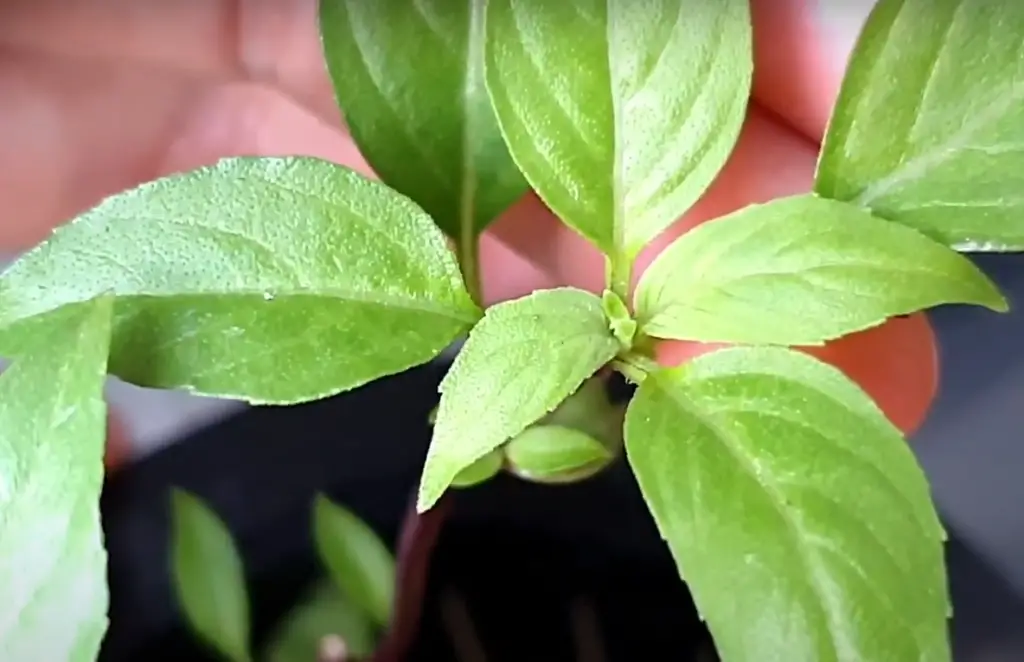
Basil needs well-draining soil that is rich in nutrients, so adding compost or other natural supplements to the mix can help ensure that your plant gets enough nutrition as it grows. If you want to make sure that your basil thrives, use a fertilizer formulated for herbs such as fish emulsion or liquid seaweed extract every couple of weeks during its growing season.
Trimming the Cutting and Removing Leaves
When the time comes to insert your cutting into the soil, you will need to trim it so that just a few leaves are left near the top. You can also remove any flowers or seed pods from the stem before planting. This will help the plant focus its energy on producing roots and new growth instead of fruits or seeds. In addition, some of the lower leaves should be removed since they may draw moisture away from the cutting while it is trying to establish itself in its new environment.
Taking Care of Your Cutting After Placement in Soil
Ensuring Adequate Watering and Drainage
Basil cuttings need moist soil to take root. Water the cutting every day for the first week, making sure that excess water can drain away easily from the drainage holes in your pot or container. After the initial week, you can reduce watering to twice a week, and ultimately once per week when your basil is established.
Providing Light and Warmth
Your basil will need plenty of light to thrive and should be placed in a bright, warm position that receives full sun for at least six hours per day. If possible, you should place the cutting near a south- or west-facing window. You can also grow lights to supplement natural sunlight if needed. [3]
Monitoring for Pests and Disease
Keep an eye out for pests and diseases such as aphids, fungus gnats, or powdery mildew. If you spot any on your plant, treat the basil with a pesticide formulated for insect control or fungicide. You can also remove any affected leaves from the plant before treating it to prevent further damage.
Pruning Basil Cuttings
Basil cuttings need regular pruning so that they will stay bushy and compact rather than growing tall and leggy. Trim off tips of the stems regularly using sharp scissors to encourage new growth at the base of the plant.

Additionally, pinching back flowers is important to keep your basil productive and prevent it from going to seed prematurely.
Harvesting Your Basil
Once your basil cutting has taken root and is established, you can start to harvest leaves as needed for cooking. Pick off the freshest, topmost leaves first, and use them right away or store in an airtight container in the refrigerator. You can repeat this process every few weeks throughout the growing season.
With consistent care and attention, you should be able to successfully grow basil from cuttings! Enjoy the freshness and delicious flavor of homegrown basil year-round! [4]
Transplanting the Basil Cuttings
Getting Ready to Plant
Once your basil cuttings have grown roots of at least 1/2 inch long, it’s time to start preparing for transplanting. Choose a pot that is at least 8-10 inches deep so the roots can spread out and the plant has enough room to grow. Fill the pot with a soil mix made specifically for herbs or vegetables, such as Miracle-Gro® Seed Starting Potting Mix. Ensure that you use a pot with holes in the bottom for proper drainage and avoid overly large pots, which may hold too much moisture and cause root rot in your basil.
Planting Basil Cuttings
Place each cutting into its own individual pot filled with the prepared soil so that all but two sets of leaves are below the surface of the soil. Gently press down on the soil around each cutting to make sure it is firmly rooted and water thoroughly. Place the pots in a warm, sunny place and give them regular watering, making sure not to over-water them or let them dry out completely.
Aftercare for Transplanted Basil Cuttings
Keep an eye on your basil cuttings as they continue to grow and establish themselves in their new home. Once they have acclimated, you can feed your growing plants by adding liquid fertilizer at least once every two weeks. Give each plant enough space to grow without overcrowding it and prune off any flowers that form so all energy goes into producing leaves instead of seeds. With some patience and care, you can enjoy the taste of freshly grown basil in your cooking in no time!
Will Basil Cuttings Root in Water?
Basil cuttings can easily be rooted in water, making them a great option for propagating basil plants.
Discard any leaves that will be below the water line and remove any flowers or flower buds.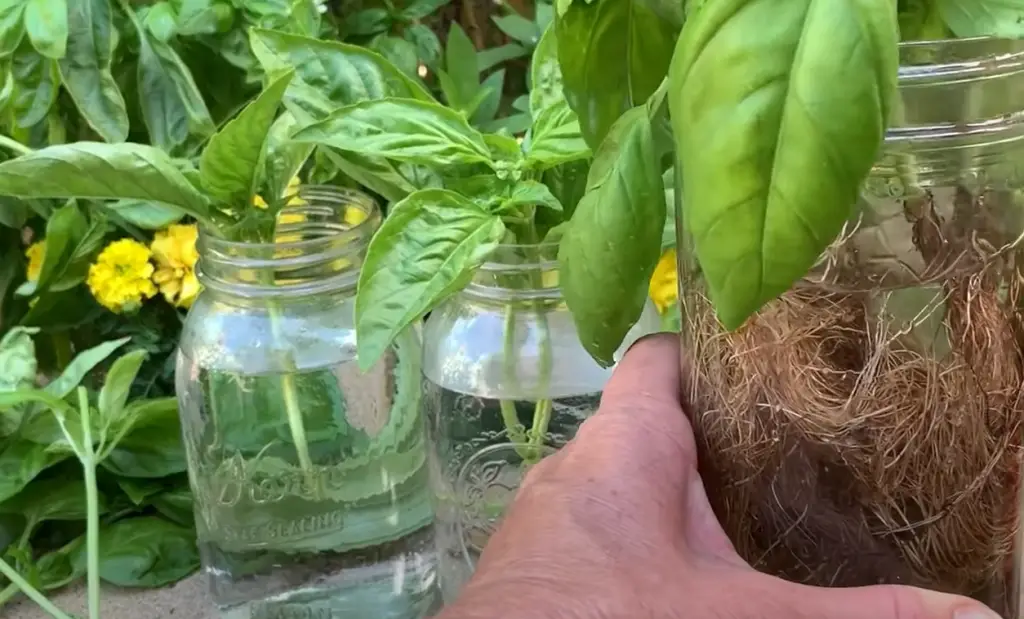
Fill a glass container with clean room temperature water and place the stem cuttings in it. Place the container in indirect sunlight or next to a fluorescent light source and change out the water every few days. The basal nodes – where new roots are most likely to emerge – should be submerged beneath the surface of the container. You may see root growth after several weeks when they have developed enough to support themselves in soil. Once they have rooted, transplant the cuttings to a potting mix and give them adequate sunlight and water. With some patience, you can quickly grow a healthy basil plant from your stem cuttings. [5]
Once established, remember to regularly prune your basil plants to encourage bushier growth and more flavorful leaves!
How Long Does It Take Basil Cuttings to Grow Roots?
It generally takes about two to three weeks for basil cuttings to produce roots. Basil cuttings should be inserted into a medium that is moist and well-draining, such as potting mix or vermiculite. Make sure the medium you are using is not waterlogged; if necessary, use a well-draining container so excess moisture can drain away. The temperature of the environment should be at least 70F (21C).
To promote root growth, keep the cutting in an area with bright light but out of direct sunlight. To help retain moisture around the cutting during this period, consider covering it with a clear plastic bag or jar lid. Check on your cutting every few days to monitor progress and adjust the environment, if necessary.
Once roots have formed on your basil cutting, you can pot it up in soil and continue to grow it indoors or outdoors. Make sure the new pot is large enough to accommodate the roots that have developed. Depending on where you will be planting your basil cutting (indoors or outdoors), provide the appropriate amount of sunlight and water accordingly. With a bit of care and attention, your basil cutting should start producing leaves within a few weeks!
Do Basil Cuttings Need Sun?
Yes, basil cuttings need a lot of sun to grow. Place the cutting in an area that receives at least 8 hours of direct sunlight each day.
Keep the soil moist but not soggy and mist the leaves daily. You can also use a clear plastic bag over the container to create a mini-greenhouse effect and help keep moisture levels up.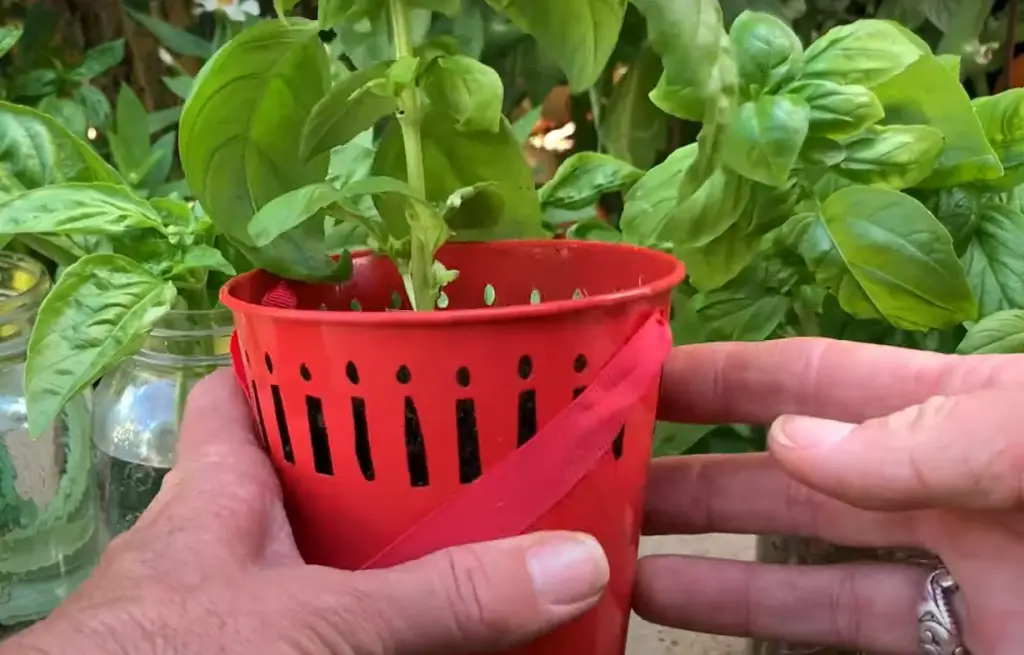
Within 1-2 weeks, you should start seeing new growth on your cutting! Once the roots are established and your plant is growing well, you can transplant it outdoors if desired. Remember to continue giving your basil plenty of sun and water for optimal growth! [6]
FAQs
How Long Does It Take For a Cutting to Grow Roots?
It usually takes between 3-5 weeks for a basil cutting to start growing roots. Once the cutting has rooted, it can be transplanted into soil and will continue to grow. To ensure successful root growth, make sure the cutting is kept moist and in indirect sunlight. When transplanting, give the plant enough space so that there is adequate air circulation around the stem. Additionally, adding a rooting hormone to your cuttings can help speed up the process of root formation.
When Should I Fertilize My Basil Plants?
You should fertilize your basil plants every other month during the growing season using a balanced fertilizer. Make sure to follow package instructions for proper application and dosage. It’s best to avoid over-fertilizing, as this can lead to nutrient deficiencies and yellowing of the leaves. Additionally, make sure not to fertilize newly transplanted cuttings until they have fully established themselves in their new environment.
Can I Use Any Type of Soil To Grow Basil From Cuttings?
Yes, you can use any type of soil to grow basil from cuttings. The best soil for growing basil is one that is well-draining and rich in organic matter, such as compost or aged manure. A slightly acidic soil pH level between 6.0 and 7.5 is ideal for optimal growth of basil plants. Before planting the cuttings, amend the soil with a balanced fertilizer to ensure it contains all essential nutrients needed by the plant for healthy growth. When planting your cuttings, make sure to dig a hole about twice as deep and wide as the cutting itself so that it has enough room to take root and spread out its roots. Once planted, water the area deeply until soaked through and keep your basil plant well nourished with regular watering and fertilizing. With the proper care, you can grow healthy basil plants from cuttings in no time!
Should I Prune My Basil Plants After They Flower?
Yes, pruning your basil plants after they flower is recommended to help promote healthy growth. Removing the flowers will prevent the plant from wasting energy on seed production and instead focus its efforts on growing more leaves, which will provide you with a larger crop of flavorful herbs. Prune your basil plants back to their desired size and shape by removing any dead or dying stems, as well as those that are overgrown or crossing each other. Pinch off flowers you see developing to ensure your basil plants maintain their bushy shape and encourage new leaf growth. With proper care and regular pruning, you can keep your basil plants looking lush and healthy all season long!
How many times does basil regrow?
The exact number of times that basil can regrow from cuttings is impossible to determine, as it depends on the variety, environmental conditions and the care given to the plants. Generally speaking, however, basil can be propagated through cuttings multiple times before you need to start with new plants. With proper care and regular pruning, a single plant can provide multiple harvests over many months. Regular harvesting also encourages more vigorous growth and higher yields. If your basil starts to look weak or spindly, discard it and start with a new cutting. To keep your basil healthy and productive for several harvests, fertilize regularly throughout the season with a balanced liquid fertilizer or fish emulsion solution applied according to package instructions. Finally, make sure that your plants are well-watered and not left to dry out between waterings. Doing so will help ensure a healthy, abundant harvest from your basil cuttings for many months.
What is the lifespan of a basil plant?
Basil plants typically last for 1-2 years before they need to be replaced. During this time, it is important to regularly prune and maintain your basil plant in order to keep it healthy and get the most out of it. With proper care and attention, you can extend the life of your basil plant beyond this time frame. It is also possible to start new plants from cuttings taken from an existing mature basil plant, allowing you to enjoy a fresh supply of the herb for many more years!
Can basil survive winter?
No, basil is an annual herb and will not survive the winter. When temperatures drop below 40 degrees Fahrenheit (4°C), the plant will suffer damage, and any remaining leaves may become limp or brown. If you want to harvest basil throughout the year, you can grow it indoors in a container, where temperatures can be more easily controlled. Alternatively, you can sow new seeds each spring once outdoor temperatures begin to warm up. With good care, your basil plants should thrive during the growing season.
How do I know when my basil is ready to harvest?
When you can see that the basil plant is growing well and looks healthy, it’s time to harvest. You’ll also want to wait until your basil has multiple stems of leaves and flowers blooming before you pick any. Generally speaking, the larger the leaf, the more flavourful it will be. Try not to pick off all of the upper leaves so that they can help provide shade for lower ones still being developed. When harvesting, cut off stems with scissors or pinch them from as close to the base as possible. After harvesting, enjoy your fresh basil in salads, sandwiches, sauces and other dishes!
Useful Video: How to Root Basil from Cuttings in Water for an Endless (FREE) Supply 🌿
Conclusion
Growing basil from cuttings is an easy and cost-effective way to propagate your herbs. Cut a healthy stem at an angle, strip off any lower leaves, and dip the cut end in rooting hormone before planting. Place in moist soil or water and wait for it to take root. With proper care, your cutting should be ready to transfer into a pot after six weeks. Enjoy fresh basil all season long!
References:
- https://savvygardening.com/growing-basil-from-cuttings/
- https://homesteadandchill.com/propagate-basil-cuttings/
- https://garden-basics.com/growing-basil-from-cuttings/
- https://www.gardeningknowhow.com/edible/herbs/basil/propagating-basil.htm
- https://www.gardenerbasics.com/blog/growing-basil-from-cuttings
- https://thecafesucrefarine.com/how-to-root-basil-from-cuttings/





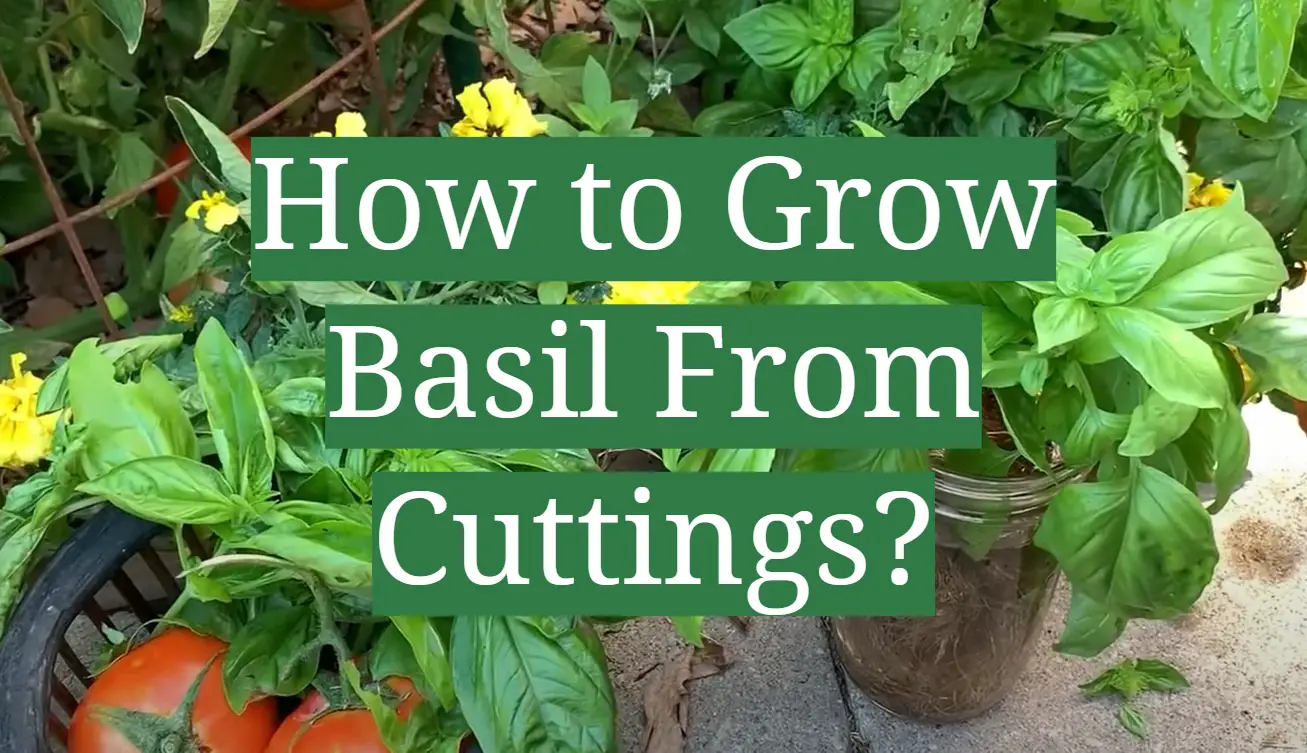




Leave a Reply
View Comments